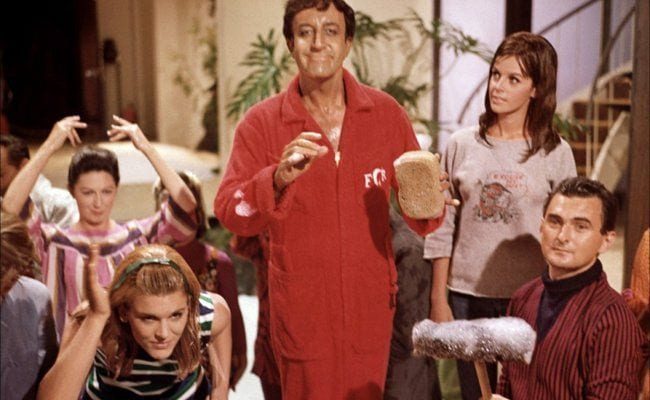
The Party begins with shots of the blue skies and vistas of a Hollywood epic before it segues into a long gag about a military hornblower wailing through his injuries. This, in turn, is revealed as more metatextual sort of bumbling: we’re watching a movie set, and a take ruined by Hrundi Bakshi (Peter Sellers), an Indian actor who goes on to lose his gig when he accidentally blows up a massive outdoor set in the style of, well, a comedy starring Sellers and directed by Blake Edwards (somehow, no one in the movie recognizes this signature bit of large-scale slapstick).
All of this happens in the first five minutes or so of the movie, providing set-up for a ruthlessly efficient mix-up: when the director calls the producer to demand that Bakshi never work in this town again, the producer jots down his name on a slip of paper that turns out to be a guest list for a swanky Hollywood party. His secretary takes the name as a last-minute addition, and soon Bakshi is hobnobbing among the very people he’s supposed to be exiled from.
This all needs to happen quickly because Edwards has elaborate slapstick set pieces to devise, and almost all of them (save the opening explosion) take place in an ultra-modern (circa 1968) Los Angeles pad. The Party runs for 100 minutes, most of it taking place at this single location during this single event. It might sound like a bit much, and it is, but Edwards and Sellers are more than up to killing the time; they can devote a solid five minutes to Sellers simply losing and recovering his shoe on his way into the house.
Some of this material is funny, and some of it is even surprisingly subtle, like the little hand-dance Sellers does when trying to remove his tie, after it gets stuck under the arm of the party’s host. But not all of the movie’s scenes proceed with such unavoidable comic logic; at one point, Bakshi walks up to a control panel on a wall and simply begins pressing buttons at random. There’s a half-hearted payoff to this bit during the movie’s climax, but the initial mayhem isn’t all that funny — not just because people falling into pools isn’t especially funny on its own, but because at that point Bakshi truly is making a nuisance of himself. If The Party sometimes more technically impressive than laugh-out-loud funny (primarily for its individual feats of choreography and its commitment to building a feature film around them), the film does tap into a near-universal anxiety: who hasn’t, like Bakshi, arrived at a party or gathering and felt somehow out of place?
It’s a good thing that this registers some empathy, because it’s also an unavoidable fact that Sellers is performing in brownface. Of course, cultural values were not the same in 1968 as they are now, almost fifty years later, and to Sellers’ credit, Bakshi is only a figure of fun in the sense that most of his slapstick creations are. Like his Inspector Clouseau, the bumbling detective he and Edwards were taking a break from during this film, Bakshi has no malice in his heart, and is ultimately the movie’s hero. The brownface, unfortunate as it looks now, doesn’t entirely play as racist caricature because chameleonic comedy was the actor’s stock in trade. The Indian character is just another Sellers mask, regardless of the extremely poor taste.
No such context is provided on the Blu-ray of The Party, which presents only the film in a high-definition transfer that does show off the widescreen frames that Edwards fills with people, then mayhem, often panning across semi-wide shots to track Bakshi’s unwitting havoc. The movie doesn’t have much of any place to go beyond the creation of additional havoc, so it must up the ante with bigger slapstick, floods of bubbles, and, eventually, an elephant in a pool, why not. The movie’s descent into ’60s anarchy has an admirable lack of arc for the Sellers character, beyond a sweet if wisp-thin romance between Bakshi and another partygoer. But as foolish as some of the Hollywood windbags wind up looking, Edwards isn’t really after anything satirical, beyond the vague subtext of a polite Indian man sending a group of mostly white people into chaos. He and Sellers are just there to have a pretty good, expertly staged time.

